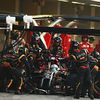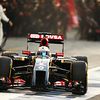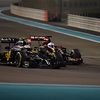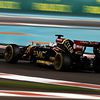Lotus E22 Renault
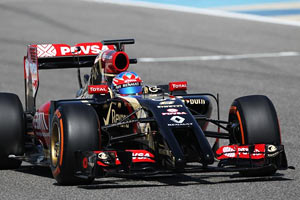
Active: 2014
Team: Lotus F1 Team
Team: Nick Chester (TD), Matthew Carter (CEO), Gerard Lopez (TP)
Drivers: Romain Grosjean (8), Pastor Maldonado (13), Charles Pic (Reserve), Marco Sorensen (Reserve), Nicolas Prost (Reserve)
Lotus struggled through a difficult second half of 2013 with key staff leaving due to the team being unable to pay wages. First to leave was James Allison, and he was later joined by, among others, the team's head of IT and Eric Boullier, team principal until the end of 2013. All those who left certainly have had their influence on the new E22, but the final year of development was led by Nick Chester, the team's new technical director after the departure of Allison.
Among further rumours of financial issues, the team also decided to delay the car's launch until after the first test, opting to keep on working at its home base until going to Jerez for a private 2 days of filming on 6 and 7 February. The car publicly debuted at the Bahrain winter test, starting on 19 February.
Technically, the car at the launch featured a unique, asymmetric twin tusk nose cone, the team's attempt to get as much air as possible underneath the nose cone while complying with the changed regulations that mandate a low nose cone. The rear end of the car was more conventional, even though it was also the only car to have its exhaust pipe not on the centreline of the car, but rather moved slightly to the right to make room for the curved single central pillar.
Lotus ran its car during the two remaining tests at Bahrain before the season, but soon found it unreliable, mostly due to the troubled Renault engine. The car was often sidelined while the team and its engine supplier were fixing software bugs. Two engine fires during the final test also severely cut running short and left a lot of questions before going to Melbourne for the Australian Grand Prix.
As of the first race, it was obvious that Lotus was far from ready to be competitive, resulting in terribly pace and reliability. It was only by race 5, the Spanish GP where the car profited from a considerable upgrade package, targeted at improving rear stability under braking, more consistency of the aerodynamics and keeping the tyres in the right operating temperatures. The Lotus E20 and Lotus E21 were managing tyre life particularly well, but with the harder Pirelli compounds of 2014, the team had difficulty keeping the tyres in the proper temperature range.
With the updates, Romain Grosjean qualified 5th and eventually finished 8th, followed by another 8th place finish in the Monaco GP. As others progressed, the Lotus continued to be an ill handling car, and once the FIA banned interlinked suspension (FRIC), the situation worsened as the team had one of the better systems on the grid. Following a dismal free practice at the Italian GP, Grosjean said the team already halted development of the E22 in favour of developing the E23 for 2015.
Part of Lotus' issues were to be sought in their packaging of the drivetrain components. The team designed its car to have the power unit control elements located underneath the fuel tank, similar to Toro Rosso, but potentially also a hotter area than having them low down in the sidepods. The team also used a water to air intercooler which, according to several knowledgable sources, led to higher air temperatures going into the ICE, meaning a potential reliability problem for the engine. In general though, the team lacked resources to get everything sorted properly and continued to struggle with the reliability of its new 8-speed gearbox throughout the entire season.
Specifications
Chassis: Composite monocoque structure, designed and built in-house, carrying the Renault V6 as fully stressed member
Wheels: OZ Racing (Front: 12.0in x 13in diam., Rear: 13.7in x 13in diam.)
Tyres: Pirelli
Front suspension: Carbon fibre top and bottom wishbones operate an inboard rocker via a pushrod system. This is connected to a torsion bar and damper units which are mounted inside the front of the monocoque. Aluminium uprights
Rear suspension: Carbon fibre top and bottom wishbones with pull rod operated torsion springs and transverse-mounted damper units mounted inside the gearbox casing. Aluminium uprights
Brakes: Carbon - Carbon. Calipers by AP Racing, master cylinders by AP racing and Brembo.
Electronics: MESL standard electronic control unit
Fuel system: Kevlar-reinforced rubber fuel cell by ATL
Dimensions
Front Track: 1450 mm
Rear Track: 1400 mm
Overall Length: 5088 mm
Overall Height: 950 mm
Overall Width: 1800 mm
Overall Weight: 692kg, with driver, cameras and ballast
Transmission
Gearbox: Eight-speed semi-automatic titanium gearbox with reverse gear. “Quickshift” system in operation to maximise speed of gearshifts
Powertrain
Designation: Renault Energy F1-2014
Type: Turbocharged, 90° 1.6l V6, assisted with kinetic and heat ERS
Valves: 24 (4 per cylinder)
Engine Construction: Cylinder block in aluminium
Rev limit: 15,000rpm
Pressure charging: Single turbocharger, unlimited boost pressure (typical maximum 3.5 bar abs due to fuel flow limit)
Bore: 80mm
Stroke: 53mm
Crank height: 90mm (minimum allowed)
Exhaust: Single exhaust outlet, from turbine on car centre line
Injection: Bosch direct fuel injection, limited to 500bar
Weight: Undisclosed (at least 145kg)
Total horsepower: Approximately 600hp (ICE) + 160hp (ERS)
Energy recovery system: Integrated Hybrid energy recovery via electrical Motor Generator Units, by Renault Sport
Electronic Control Unit: Magnetti Marelli
Energy Store: Lithium-Ion battery solution (up to 4MJ per lap), between 20 and 25 kg, by Renault Sport

